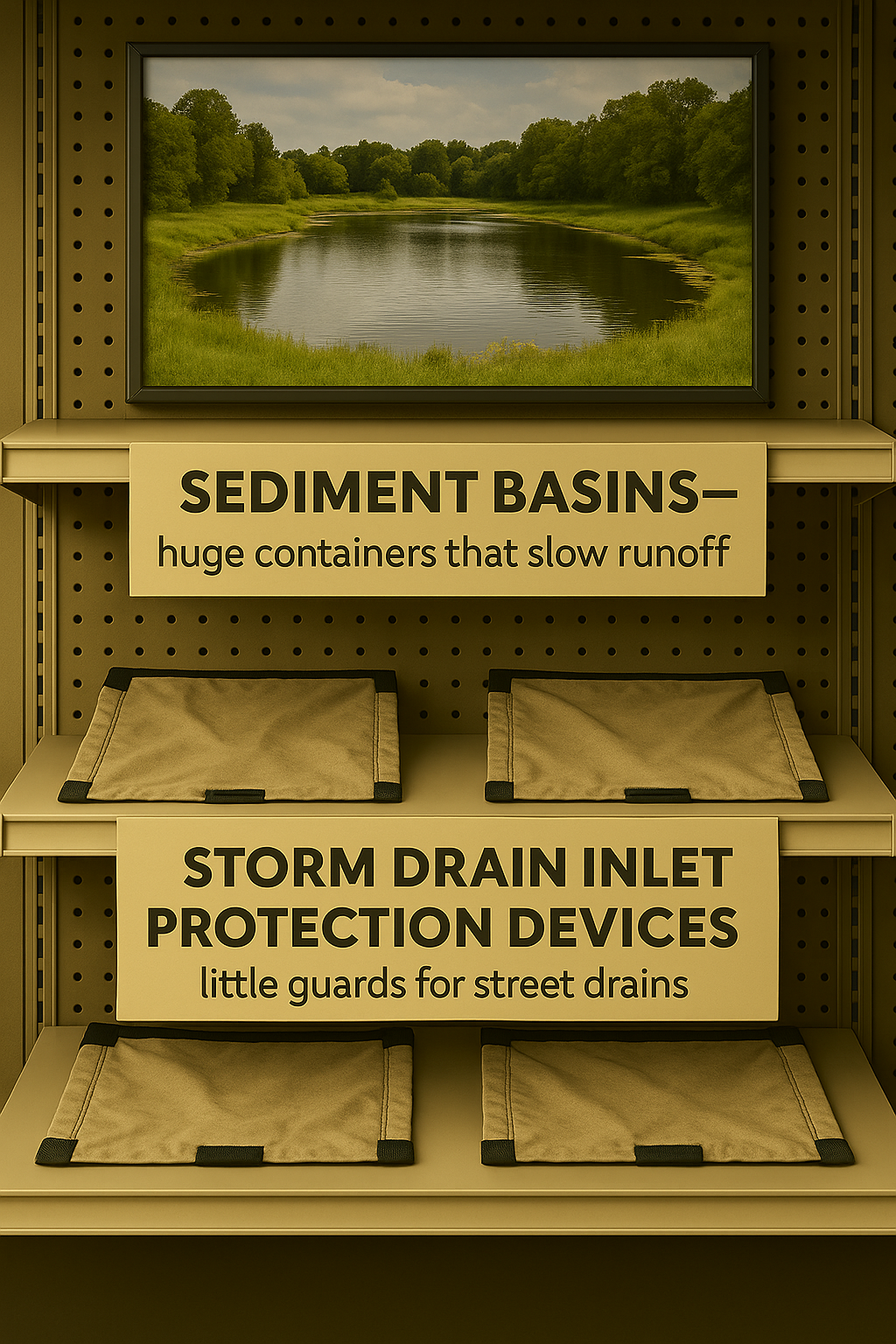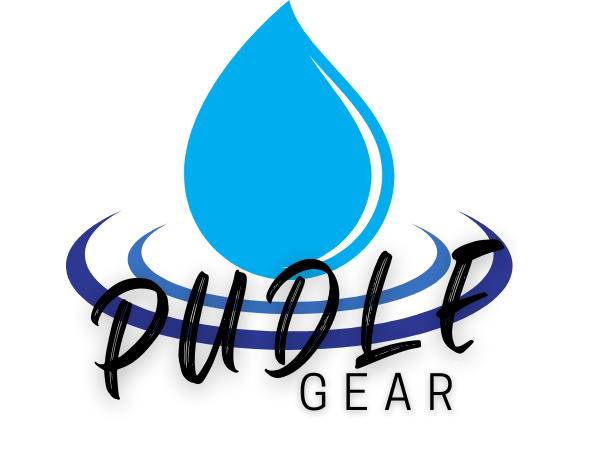BMPs R Us: Build Your Best Site!
A Stormwater Defenders Learning Adventure featuring Sergeant Stormwater!
Sergeant Stormwater pushed open the doors of BMPs R Us and marched inside. You and the other recruits followed behind, curious.
His boots echoed across the polished floors as he looked around.
Shelves stretched as far as the eye could see — packed full of Best Management Practices (BMPs) of every shape, size, and color.
He adjusted his hat and nodded.
"Alright, recruits. Today’s mission is simple: Choose the right BMPs to defend Watershed City! But first, we need to know what tools are out there and how to use them."
He pulled out his notebook and waved you forward.
"Let’s go shopping — Stormwater Defenders style."

Aisle 1: Erosion Control BMPs - The Soil Shield

Sergeant Stormwater marched down the first aisle labeled:
Erosion Control.
"When rain falls on bare soil, it can wash the soil away, clogging rivers, damaging habitats, and making water dirty. Erosion Control BMPs protect the soil and stop this from happening."
The shelves held:
- Silt Fences — long rolls of fabric, ready to catch moving soil.
- Erosion Control Blankets — soft mats woven from straw and fiber.
- Wattles — giant flexible sausages made of straw!
Sarge explained:
"Silt fences act like guards — standing strong to stop sediment before it escapes construction sites. Erosion control blankets cover the ground to protect it from the rain's direct hits. Wattles help slow the water on slopes, letting water sink into the soil."
"Always install silt fences by burying the bottom edge underground. Stake blankets tightly so they don't blow away. Place wattles across slopes, not up and down!"
Mission Tip:
First shield the soil, THEN start building.
If you skip erosion control, you fight a losing battle from the start!
Aisle 2: Sediment Control BMPs - The Last Line of Defense
Down the next aisle, labeled: Sediment Control,
Sergeant Stormwater stopped.
"Sometimes, no matter how careful we are, sediment gets loose. Sediment Control BMPs are the catchers — the defenders that trap dirt before it reaches the water."
On the shelves sat:
- Sediment Basins — huge containers that slow runoff.
- Storm Drain Inlet Protection Devices — little guards for street drains.
Sarge said:
"Sediment basins are like a time-out zone for dirty water. It enters fast, slows down, and lets the dirt settle to the bottom.
Storm drain protectors stop trash and sediment from getting sucked into the stormwater pipes — our last chance before it hits the river!"
"Clean inlet protection devices often - clogged ones cause flooding! Check sediment basins after every storm to remove buildup."
Mission Tip:
Catch sediment close to the source.
Don't let it run wild across the city!

Aisle 3: Runoff Control BMPs - Slow It Down, Soak It In

At the third aisle, labeled: Runoff Control, Sergeant Stormwater nodded approvingly.
"Water moves faster when it can't soak into the ground. Fast water causes erosion, pollution, and flooding. Runoff Control BMPs slow the flow and give rain a chance to soak in."
On the racks:
- Manufactured Berms - tubes or triangle berm barriers.
- Check Dams - small rock or sandbag barriers.
- Diversion Berms - mini-hills made to redirect flow.
Sarge explained:
"Check dams in ditches slow the water's rush. Berms gently push runoff toward safe areas."
"Install check dams in series along steep ditches.
Build diversion berms across gentle slopes before grading begins."
Mission Tip:
Slow the flow!
Fast water is dangerous water.
Aisle 4: Pollution Prevention BMPs - Stopping Problems Before the Start
They arrived at the Pollution Prevention section. Sergeant Stormwater lowered his voice, almost like he was sharing a secret.
"This aisle...is the most powerful one. Pollution Prevention BMPs don't just manage pollution - they prevent it from happening
in the first place!"
On display:
- Downspout Filters — mini-filters for rooftop runoff.
- Spill Kits — emergency supplies for chemical spills.
- Material Storage Covers — protective tarps and lids.
Sarge pointed:
"Downspout filters clean rainwater right off the roof. Spill kits let you clean chemical messes FAST. Storage covers keep trash and pollutants from blowing into the streets and drains."
"Always have spill kits where chemicals are used or stored. Cover dumpsters and outdoor storage piles. Inspect downspout filters regularly for clogs."
Mission Tip:
Prevent before you react.
It's easier to stop pollution than to clean it up later!

Aisle 5: Green Infrastructure - Getting back to Nature

Finally, Sergeant Stormwater ushered the recruits into the outdoor nursery. He lowered his voice again, almost like he was embarrassed.
"This is one of my favorite places in the store.
Native plants for Rain Gardens and Bioretention Planters help stormwater flow like it did before sidewalks and building were put on the landscape!"
On the display:
- Native Plants — plants chosen specifically for the climate and region in which they thrive.
- Bioretention Soils — special soil that helps stormwater soak in and removes pollutants.
- Permeable Pavement Panels — spongy-looking concrete blocks.
Sarge pointed:
"Permeable pavement acts like a sponge, letting rain soak through streets and sidewalks. Native plants survive better in the climate that they naturally occur."
"Rain gardens and urban planters often have special soils called bioretention soils to help remove pollutants. Place permeable pavement only where the soil underneath can drain!"
Mission Tip:
Greening up a grey environment.
It helps stormwater and looks better too!
The Shopping Mission Complete!
Sergeant Stormwater loaded his cart with everything he needed.
He turned to the recruits and smiled.
"Good work, recruits! Remember: Every BMP you install, every storm you prepare for, every pollutant you prevent — it's all part of protecting Watershed City.
Shopping for BMPs isn’t about buying stuff... It’s about buying TIME for clean water."
He handed you a BMPs R Us badge.
"Welcome to the team. Now let’s get out there and defend the drain!"






